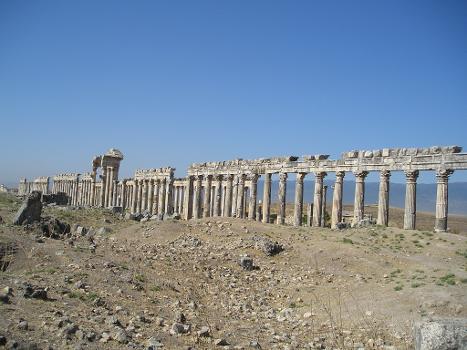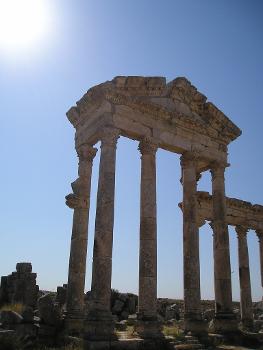General Information
| Completion: | 2nd century |
|---|---|
| Status: | in ruins |
Project Type
| Structure: |
Column and beam structure |
|---|---|
| Function / usage: |
Antique road |
| Material: |
Masonry structure |
| Architectural style: |
Hellenistic Roman |
Location
Technical Information
Dimensions
| length | ca. 2 km |
Materials
| columns |
stone
|
|---|---|
| beams |
stone
|
Excerpt from Wikipedia
The Great Colonnade at Apamea was the main colonnaded avenue of the ancient city of Apamea in the Orontes River valley in northwestern Syria. It was built in the second century CE after Apamea's devastation in the 115 earthquake. The avenue, which runs for nearly 2 kilometres (1.2 mi), made up the city's north-south axis, or the cardo maximus. The monumental colonnade is among the longest and most famous in the Roman world.
Overview
The original Hellenistic colonnade was devastated, along with the rest of Apamea, in the 115 earthquake. Reconstruction started immediately under the Romans, and over the course of the second century the city was completely rebuilt, starting with the Great Colonnade.
The colonnade was aligned along the north-south axis, making up the city's cardo maximus under the Romans. Starting at the city's north gate, the colonnade ran in an uninterrupted straight line for almost 2 kilometres (1.2 mi) to the south gate. The northern third of the colonnade's stretch is marked by a monumental votive column that stood opposite the baths. The southern third, at around 1,500 metres (4,900 ft), is marked by the intersection with the city's main east-west axis, or the decumanus maximus. Two triple arches were built into the Great Colonnade as part of the intersection. The colonnade was further intersected by side streets at regular intervals of 110 metres (360 ft). The colonnade passed through the center of the city and several important buildings were clustered around it, including the baths, the agora, the Temple of Tyche, the nymphaeum, the rotunda, the atrium church and the basilica.
The street within the colonnade was 20.79 metres (68.2 ft) wide and paved with large polygonal limestone blocks. On either side of the street a 6.15 metres (20.2 ft) wide colonnade ran ist full length. The columns were 9 metres (30 ft) high and 0.9 metres (2 ft 11 in) in diameter. They stood on square bases of 1.24 metres (4 ft 1 in) on a side and 0.47 metres (1 ft 7 in) high. The columns display two main designs: a plain one, and the distinctive spiral-flutes. Archaeologist Jean Lassus argues that the former dates back to the Trajanic period, while the latter to that of Antoninus Pius. The colonnade's porticoes were paved with extensive mosaics along the full stretch of the colonnade.
Under the Byzantine Emperor, Justinian I, several parts of the colonnade were restored. The street was narrowed to 12 metres (39 ft) by adding a sidewalk on either side. Several stretches of the street had their Roman pavement replaced with a new pavement made of squared blocks of limestone. The new pavement also covered a completely overhauled drainage system. Justinian's changes included erecting a monumental tetrastylon made up of four 9 metres (30 ft) high columns with a meter-high capitals. The city, was however, later sacked by the Sasanians under Adarmahan.
Text imported from Wikipedia article "Great Colonnade at Apamea" and modified on July 23, 2019 according to the CC-BY-SA 4.0 International license.
Participants
Currently there is no information available about persons or companies having participated in this project.
Relevant Web Sites
- About this
data sheet - Structure-ID
20061598 - Published on:
16/09/2011 - Last updated on:
28/05/2021






